| This photo shows Howard Y. Bary, circus owner, showman, adventurer, and collector of exotic attractions and oddities. He has his hand on a huge male African elephant with the animal’s cornac (mahout) standing alongside. |
Wednesday, June 18, 2008
African Elephant Domestication (From Richard Reynolds)
Posted by
Buckles
at
6/18/2008 06:20:00 AM
![]()
Subscribe to:
Post Comments (Atom)






0 comments:
Post a Comment